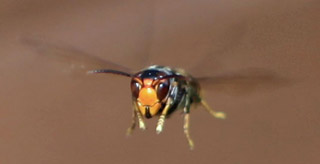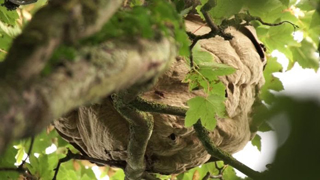 Not much is happening with the bees at this time of year, especially with the colder weather suddenly upon us. The poor things are cuddling up to one another to keep their queen alive and themselves warm – or rather, insulated, because their warmth comes from the stores they are eating. The idea of clustering is to contain the warmth they are generating and minimise its loss to the colder air within the hive beyond the outer layer of the cluster. Remember, the hive has a permanently open entrance (it’s like leaving your front door permanently open during the winter – we, at least, can close it if we choose – but the bees do not have a choice and need the open entrance to allow for adequate ventilation in order to get rid of excess moisture in the air in the hive from their exhalations).
Not much is happening with the bees at this time of year, especially with the colder weather suddenly upon us. The poor things are cuddling up to one another to keep their queen alive and themselves warm – or rather, insulated, because their warmth comes from the stores they are eating. The idea of clustering is to contain the warmth they are generating and minimise its loss to the colder air within the hive beyond the outer layer of the cluster. Remember, the hive has a permanently open entrance (it’s like leaving your front door permanently open during the winter – we, at least, can close it if we choose – but the bees do not have a choice and need the open entrance to allow for adequate ventilation in order to get rid of excess moisture in the air in the hive from their exhalations).

In the meantime, it is appropriate to remind ourselves of the impending problem we have only tasted slightly so far, that of the Asian Hornet. Now is the time of year that over-wintered queens (the “foundress” queens) will be coming out of hibernation and starting to build their primary nests to start a new colony for the season.

It is essential we all keep an eye open for these queens, either by baiting traps for them and monitoring the captures in those traps, or by keeping our eyes peeled for structures much akin to ordinary wasp nests (ie like a 1960’s paper lamp shade, for those who remember that far back!). These will generally be found at a much lower height than the main nest which is found at 40’ or 50’ up in the trees. These primary nests are to be found as low as about 2 metres off the ground in shrubs or bushes and if found can allow us to nip the offenders in the bud before they build up a huge colony.

Last year we had sightings of Asian Hornets from Hampshire, up to Lancashire and down here in Cornwall, some sightings resulting in nests being found and destroyed, others where no nests were found. This could mean that there are already over-wintering queens just waiting for the right moment to come out and start their new colonies – and we need to be ready for them!

In France, the public and the government were not ready and as a result the territory of the hornet has expanded at an alarming rate along the Channel coast, virtually doubling in the number of nests found in 2018 (5,665) compared with 2017 (3,000). Normandy, initially the department with the slowest increase in hornet populations, has now caught up with the other more southerly departments with a tripling of nests in 2018!
This does not auger well for us since, with the warm autumn last year and the southerly winds, many hornets will either have flown across the Channel or hitched a lift in a caravan, on a lorry, on a train, a boat or a car – you name it. One way or another the Asian Hornet will have entered our country and will be producing far more nests this year than have been seen to date.
 Whilst the ability to track hornets flying back to their nests is now a proven scientific capability using radio tags (thanks to the work done at University of Exeter, Falmouth by Dr Peter Kennedy), this is totally dependent upon the hornets being spotted in the first place – by beekeepers or by you, the members of the public. Monitoring traps need to be placed outside once the air temperature reaches about 120C for a few days.
Whilst the ability to track hornets flying back to their nests is now a proven scientific capability using radio tags (thanks to the work done at University of Exeter, Falmouth by Dr Peter Kennedy), this is totally dependent upon the hornets being spotted in the first place – by beekeepers or by you, the members of the public. Monitoring traps need to be placed outside once the air temperature reaches about 120C for a few days.
We beekeepers need to group our hives together, as there is safety in numbers, single hives being a lot more vulnerable. We need to allow the grass in front of the hives to grow long, thereby giving the bees

somewhere to hide until the hornet s move away. We need to close our hive entrances down to 5mm once the drones start flying – and we need to put traps out to reduce the amount of predation that takes place. We can also fit a mesh “muzzle” in front of the hive entrance using 10mm x 10mm or 12mm x 12mm square wire mesh. Such a muzzle has no impact on the bees but does impede the ability of the Asian Hornet to predate on them.

I will be writing more about the Asian Hornet in future blogs here but suffice it to say that we must not do what the French did and just lie back hoping the problem will go away. DEFRA and the NBU are ready and able to help us combat this environmental threat but we must take steps ourselves to enable them to do their detection and elimination work more effectively with the limited resources at their disposal.
Until next month, do have a bash at making a monitoring trap. More importantly, please keep a look-out and report any (even suspected) sightings of Asian Hornets to myself or to alert_nonnative@ceh.co.uk (there is an underscore after the word “alert”) – we will take it from there, taking appropriate precautions and using appropriate protective equipment. Do not put yourself at risk but please do let someone know what you have seen.
Colin Rees – 01872 501313 – 07939 971104 – colinbeeman@aol.com
